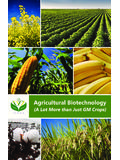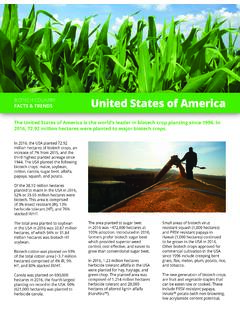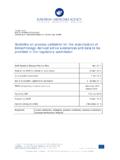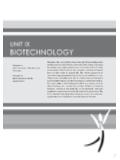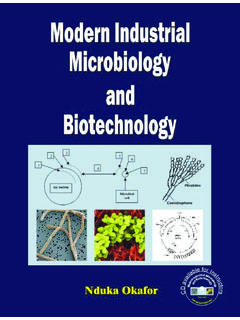Transcription of Agricultural Biotechnology - ISAAA.org
1 1(A Lot More than Just GM Crops) Agricultural Biotechnology2 All living organisms have the ability to improve themselves through natural means in order to adapt to changing environmental conditions. However, it takes hundreds of years before any detectable improvement is obtained. Man then learned how to domesticate and breed plants in order to develop crops to his own liking and needs using various means including Biotechnology . Biotechnology is defined as a set of tools that uses living organisms (or parts of organisms) to make or modify a product, improve plants, trees or animals, or develop microorganisms for specific uses.
2 Agricultural Biotechnology is the term used in crop and livestock improvement through Biotechnology tools. This monograph will focus only on Agricultural crop Biotechnology . Biotechnology encompasses a number of tools and elements of conventional breeding techniques, bioinformatics, microbiology, molecular genetics, biochemistry, plant physiology, and molecular biology. The Biotechnology tools that are important for Agricultural Biotechnology include: - Conventional plant breeding - Tissue culture and micropropagation - Molecular breeding or marker assisted selection- Genetic engineering and GM crops- Molecular Diagnostic Tools SandraMatic / Plant BreedingSince the beginning of agriculture eight to ten thousand years ago, farmers have been altering the genetic makeup of the crops they grow.
3 Early farmers selected the best looking plants and seeds and saved them to plant for the next year. The selection for features such as faster growth, higher yields, pest and disease resistance, larger seeds, or sweeter fruits has dramatically changed domesticated plant species compared to their wild relatives. Plant breeding came into being when man learned that crop plants could be artificially mated or cross-pollinated to be able to improve the characters of the plant. Desirable characteristics from different parent plants could be combined in the offspring. When the science of plant breeding was further developed in the 20th century, plant breeders understood better how to select superior plants and breed them to create new and improved varieties of different crops.
4 This has dramatically increased the productivity and quality of the plants we grow for food, feed and plant breeding (Figure 1) has been the method used to develop new varieties of crops for hundreds of years. However, conventional plant breeding can no longer sustain the global demand with the increasing population, decline in Agricultural resources such as land and water, and the apparent plateauing of the yield curve of the staple crops. Thus, new crop improvement technologies should be developed and breedingThe art of recognizing desirable traits and incorporating them into future generations is very important in plant breeding.
5 Breeders inspect their fields and travel long distances in search of individual plants that exhibit desirable traits. A few of these traits occasionally arise spontaneously through a process called mutation, but the natural rate of mutation is very slow and unreliable to produce plants that breeders would like to the late 1920s, researchers discovered that they could greatly increase the number of these variations or mutations by exposing plants to X-rays and mutation-inducing chemicals. Mutation breeding accelerated after World War II, when the techniques of the nuclear age became widely available.
6 Plants were exposed to gamma rays, protons, neutrons, alpha particles, and beta particles to see if these would induce useful mutations. Chemicals such as sodium azide and ethyl methanesulphonate, were also used to cause mutations. Mutation breeding efforts continue around the world today. In the 73 years of mutation breeding (1939-2013), a total of 3,218 varieties obtained through mutation breeding have been registered in the IAEA database. Staple crops such as rice has registered 824 varieties, barley (312), wheat (274), maize (96), common bean (57), tomato (20), potato (16), sugarcane (13), soybean (2), as well as other important crops that were improved to possess agronomically-desirable line and hybrid seed technologyThe end result of plant breeding is either an open-pollinated (OP for corn) or inbred (for rice) varieties or an F1 (first filial generation) hybrid variety.
7 OP and inbred varieties, when maintained and properly selected and produced, retain the same characteristics when multiplied. Figure 1. Conventional breeding entails sexual hybridization followed by careful selectionSource: Alfonso, A. 20075 Hybrid seeds are an improvement over OP and inbred seeds in terms of yield, resistance to pests and diseases, and time to seeds are developed by the hybridization or crossing of diversely-related parent lines. Pure lines are offsprings of several cycles of repeated self-pollination that breed true or produce sexual offspring that closely resemble their parents.
8 Pure line development involves firstly, the selection of lines in the existing germplasm which express the desired characteristics such as resistance to pest and diseases, early maturity, yield, and others. These traits may not be present in only one line, thus selected lines are bred together by hand. In self-pollinated plants, flowers are emasculated by removing the anthers or the male part of the flower by hand, and are pollinated by pollen from another line. The female parent is usually the line that possesses the desired agronomic trait while the male parent is the donor of the new trait.
9 F1 (first filial generation) offsprings are planted and selfed, as well as the F2 generation. Breeders then select in the F3 and F4 generation the lines which exhibit their desired agronomic characteristics and the added trait. Testing for resistances to pests and abiotic stresses are conducted also at this time. Lines with desired traits and are rated intermediate to resistant/tolerant to the pests and abiotic stresses are selected and selfed in two to three more generations. Lines which do not lose the new traits and are stable are termed pure lines. In hybrid seed technology, two pure lines with complementing traits and are derived from diversely related parents are bred together by hand.
10 F1 hybrids are tested for hybrid vigor in all agronomic and yield parameters and compared to both parents. The resulting offsprings will usually perform more vigorously than either the technology has been developed, it has brought tremendous impact in major crops including rice, corn, wheat, cotton, and other crops including many vegetables. In the USA, corn yield from 1866 to 1936 was only 26 bu/acre. Adoption of hybrid corn has increased corn yield by bu/ac/yr from 1947-1955. With improved genetics, availability of N fertilizer, chemical pesticide and mechanization, corn grain yield has constantly increased by bushels/acre/year to become 115 bushels in 1990 s to an expected increase of 159 bu/acre in 2012.
